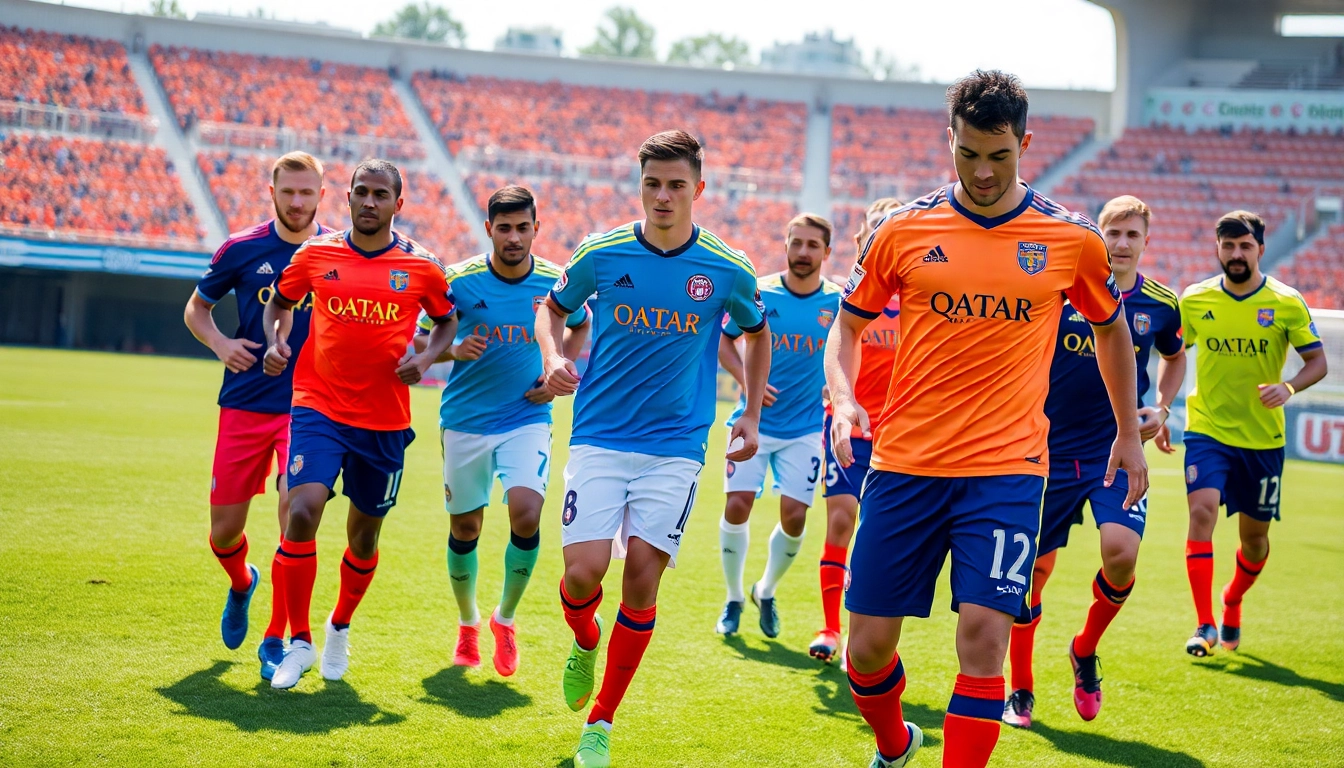When it comes to competitive sports like soccer, the importance of high-quality uniforms cannot be overstated. Soccer uniforms not only serve the fundamental purpose of identifying teams but also play a critical role in enhancing performance, boosting team cohesion, and projecting a professional image on and off the field. Whether you are outfitting a youth team, amateur club, or professional squad, choosing the right soccer uniforms involves understanding various technical, aesthetic, and practical factors. In this comprehensive guide, we delve into every aspect of soccer uniforms—from materials and design features to customization techniques and maintenance strategies—equipping coaches, players, and team managers with the knowledge needed to elevate their game through superior apparel.
For a seamless experience in selecting and acquiring top-tier soccer uniforms, visit Soccer Uniforms to explore tailored options that meet your specific requirements.
Understanding the Essentials of Soccer Uniforms
Materials and Fabric Technology for Optimal Performance
The foundation of any high-quality soccer uniform lies in the choice of materials. Modern fabric technology has revolutionized sports apparel, emphasizing lightweight, breathable, and moisture-wicking properties to keep players dry and comfortable during intense play. Commonly used materials include polyester blends, which are engineered for durability and stretchability. Technologies like AEROREADY, Mesh-inserts, and Coolmax fibers are now standard in premium soccer kits, facilitating superior airflow, quick-drying capabilities, and reduced chafing. For instance, Adidas’ soccer jerseys incorporate moisture management systems that draw sweat away from the skin, preventing discomfort and maintaining optimal body temperature.
Design Features that Enhance Player Comfort and Flexibility
Design is equally important, with ergonomic cuts that accommodate movements such as sprinting, jumping, and sliding. Flatlock seams prevent skin irritation, while strategically placed stretch panels offer freedom of movement. Additionally, fit considerations—like tailored sizes and elastic waistbands—ensure that uniforms stay securely in place without restricting mobility. Incorporating features such as mesh panels or vented zones boosts ventilation, especially critical during hot weather or strenuous matches. The result is apparel that supports performance through comfort and adaptability.
Latest Trends in Soccer Uniform Styles and Customization Options
Fashion-forward teams are increasingly adopting modern styles that reflect their identity. Trends include minimalist designs with subtle patterns, bold color blocking, and innovative graphic motifs. Customization has become more accessible, allowing teams to personalize their kits with unique logos, patterns, and color schemes. Advances in dye sublimation printing enable vibrant, long-lasting graphics without compromising fabric integrity. Moreover, international series and themed collections now provide diverse options for expressing team personality, whether through traditional colors or avant-garde designs. For teams seeking individuality, customizable jerseys offer an excellent platform for creative expression while maintaining professional standards.
How to Choose the Right Soccer Uniforms for Your Team
Factors to Consider: Size, Fit, and Material Durability
Selecting the perfect soccer uniform begins with assessing key factors. Size and fit are paramount; uniforms that are too tight may hinder movement, while loose apparel can become a distraction. It’s advisable to opt for slightly tailored fits based on player measurements, ensuring comfort and uniformity. Material durability is equally critical. Soccer uniforms should withstand frequent washing, exposure to dirt, and rough handling. Polyester and polyester blends are known for longevity, resistance to shrinking, and color retention. Conducting a quality test—such as washing a sample fabric—can help verify durability before bulk procurement.
The Importance of Team Branding and Logo Placement
Teaming branding and logo placement are vital in establishing a cohesive and professional appearance. Logos should be prominently placed on the chest, back, or sleeves without interfering with performance. Embroidery offers durability and a premium look, while sublimation printing ensures intricate designs are integrated into the fabric seamlessly. Consistent branding across all players fosters team unity, enhances visibility during competitions, and reinforces your team’s identity. Selecting distinct colors and motifs aligned with your team ethos creates brand recognition that can be leveraged for sponsorships and promotions.
Budgeting and Finding Quality Uniforms at the Best Price
Cost considerations are inevitable, but quality should not be compromised for affordability. A strategic approach involves comparing suppliers, seeking bulk discounts, and evaluating long-term benefits such as durability and customization options. Big-name brands like Nike or Adidas offer premium kits with advanced technology, but numerous reputable manufacturers provide cost-effective alternatives suitable for amateur and youth teams. Establishing clear specifications and negotiating with suppliers ensures you get the best value. Remember, investing in durable, well-fitting uniforms minimizes replacement costs over time and enhances overall team performance.
Customizing Soccer Uniforms to Match Your Team Identity
Designing Unique Jerseys with Colors and Patterns
Personalized jerseys are a reflection of your team’s identity and can instill a sense of pride and unity. Begin by selecting a color palette that aligns with your team logo or mascot. Patterns such as stripes, chevrons, or asymmetric graphics add visual interest. Advanced printing technologies like sublimation allow for detailed motifs and vibrant finishes that withstand repeated washing. Additionally, incorporating seasonal or special-event themes into jersey designs can foster engagement and excitement among players and fans alike. Collaborate with experienced designers or suppliers who offer mock-up previews to refine your concept before production.
Adding Logos, Numbers, and Player Names
Accurate and durable customization details elevate professionalism. Logos should be placed prominently, with player numbers and names positioned for easy identification during play. Embroidery offers a premium, long-lasting option, while heat transfer and sublimation techniques enable intricate details and color matching. The placement and size of numbers and names should adhere to league standards or personal preferences, ensuring readability from a distance. Using contrasting colors enhances visibility, especially on darker or patterned backgrounds.
Selecting Accessories: Shorts, Socks, and More
Completing a uniform ensemble involves accessories such as shorts, socks, and even branded gear like headbands or wristbands. Shorts should match or complement the jersey in material and color, with elastic waistbands for comfort. Socks should provide cushioning and moisture control, often incorporating compression zones for muscle support. Custom accessories can further unify the team’s appearance and enhance brand consistency. Attention to detail in accessories not only improves performance but also elevates the overall aesthetic appeal.
Best Practices for Maintaining Soccer Uniforms
Washing and Care Tips to Extend Durability
Proper care prolongs the lifespan of your soccer uniforms. Always follow manufacturer instructions regarding water temperature and detergents—preferably mild, bleach-free options. Turn jerseys inside out before washing to protect graphics, and wash with similar colors to prevent bleeding. Avoid fabric softeners, which can degrade moisture-wicking properties. Air drying or tumble drying on low heat is recommended, as high temperatures can cause shrinkage or fabric damage. Regular maintenance ensures vibrant colors and structural integrity over multiple seasons.
Storage Solutions for Game-readiness
Storing uniforms properly prevents creases, mold, and fabric deterioration. Use ventilated garment bags or hang jerseys and shorts in a cool, dry place. Avoid cramped storage spaces to prevent fabric distortion. Rolling uniforms can save space and minimize wrinkles. Additionally, establishing a routine for regular inspection ensures that uniforms are ready for each game, maintaining a professional look and reducing last-minute issues.
Replacing and Upgrading Your Uniforms Over Time
Even with proper care, uniforms eventually wear out. Monitor for signs of deterioration such as fading, fabric thinning, or loose stitching. Planning for periodic upgrades based on team growth, technological advances, or performance needs ensures your team remains competitive and professional. Establishing an upgrade schedule and budget allows for seamless transitions, keeping team morale high and players confident in their attire.
Boosting Team Performance and Cohesion with Quality Uniforms
The Impact of Professional Gear on Player Confidence
Uniform quality significantly influences player confidence. Well-fitted, stylish, and functional uniforms create a psychological edge by fostering pride and belonging. Players tend to perform better when their gear matches high standards, encouraging focus and determination. Providing custom and high-performance uniforms demonstrates organizational investment in players’ success, translating into improved morale and cohesiveness.
Creating a Unified Team Image for Tournaments and Leagues
Uniform consistency projects professionalism and unity on the field, which can intimidate opponents and impress spectators. Strategically designed kits reinforce brand recognition and create a memorable visual identity, beneficial for sponsorship and marketing. Ensuring that all team members adhere to standardized uniform specifications and branding guidelines promotes a cohesive appearance across various competitions.
Integrating Uniforms into Training and Game Strategy
Using team-specific uniforms during practice sessions fosters discipline and prepares players mentally for competitions. Some teams incorporate tactical elements, such as different jersey colors to denote formations or roles, into their uniform design. This integration enhances in-game communication and strategic execution, demonstrating that uniforms are more than just apparel—they are integral tools in athletic performance.



